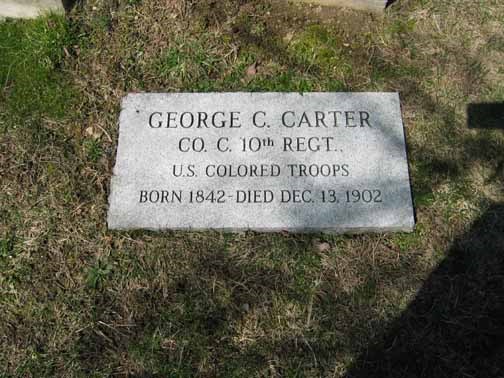Last updated: December 28, 2021
Article
George Carter: Civil War Veteran buried at St. Paul's who was born enslaved in Virginia

National Park Service
George Carter: Civil War Veteran buried at St. Paul's who was born enslaved in Virginia
George Carter was one of about 185,000 African Americans who served in the Union army in the Civil War, and he is one of several such veterans buried in the historic cemetery at St. Paul’s Church National Historic Site -- men with a special connection to the struggle for the Union and emancipation that characterized the conflict of 1861 to 1865.
Carter was born into slavery in northern Virginia in 1842. In the early days of the Civil War, he took advantage of the dislocation caused by the war and achieved his freedom by reaching Union lines at Fort Monroe, Va. In 1862, he married Rosa Quales, who had also fled from slavery at the beginning of the war. The couple eventually had four children.
The enlistment of black troops in the army -- despite their obvious incentive to fight the Confederacy -- was an enormously controversial matter in the North, and it was not until 1863 that the Union forces began accepting African American recruits. In October, Carter traveled to Hartford, Conn., and enlisted with the 10th Regiment, infantry, United States Colored Troops (USCT). Many of the early USCT regiments, filled with soldiers from across the country, were raised in New England states, where racial attitudes were somewhat more tolerant.
Carter’s regiment was involved in the campaign against Richmond from May – June 1864, and helped capture the rebels’ Fort Powhatan on May 5. The 10th was also on the front in operations against the Confederate stronghold of Petersburg through the summer of 1864. They were among the units of the Union army to enter Richmond April 2 and 3, 1865, after the fall of the Southern capital.
Following the war, Carter and his family came north in search of better lives. They lived in Babylon, Long Island, before moving to Mt. Vernon around 1880, residing in a private home on South Eighth Avenue for more than 20 years. The Union army veteran worked for several years as head gardener on a large Eastchester estate owned by George C. Clapp, who is also buried at St. Paul’s. Carter died at home on December 13, 1902, age 60. He was survived by his children and was buried in a section of the St. Paul’s burial yard used as a Mt. Vernon city cemetery. An obituary in the local Daily Argus noted that “he always bore a good reputation and was generally respected.”
Carter is memorialized through a marble veterans’ gravestone supplied by the Federal Government as part of the social responsibility of the Union to the soldiers. The markers were originally available only for men killed in battle and buried in national cemeteries, but the government stone was extended to all veterans by an act of Congress in 1879. That law led to the introduction of the marble veterans’ monument in private cemeteries, such as St. Paul’s.
